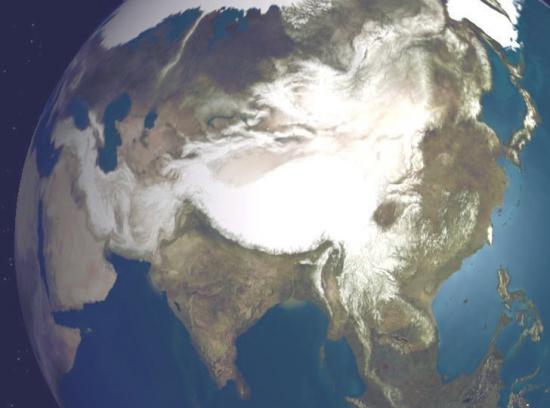BY LETTER
Asia
Galactography > Places and Locales
Galactography > Other Major Polities, Empires, and Meta-Empires > Solsys Organization
Galactography > Other Major Polities, Empires, and Meta-Empires > Solsys Organization
 Image from Steve Bowers | |
| Since the onset of the Gaiacene Ice Age much of the central Asian mountain range has been covered in ice | |
Old Earth continent bounded by Europe and by the Arctic, Pacific, and Indian oceans. It is the largest of the Old Earth continents, at 44,390,000 square kilometres. Human presence in Asia dates back nearly to the origin of Homo sapiens sapiens. Asia has always been the most populous continent, and for all but a small fraction of human history Asia sported the most advanced and powerful civilizations and polities on the planet. The exception was a brief period between about the 4th century BT to mid 1st century AT when civilizations and polities from or derived from Europe were predominant. Though the relative importance of Asia declined along with that of the rest of Old Earth during the Interplanetary Age, Asia retained its central place in human history until the Great Expulsion.
Asia was formed from the older continent of Laurasia as it separated from what was to be North America, plus elements from Gondwana, most notably the landmass that was to become the Indian subcontinent. Even without the inclusion of Europe (which is regarded by some as a subcontinent of a larger Eurasian continent by some geographers) it is the largest of Old Earth's continents, with the highest mountain range and plateau and the lowest depressions, the full range of terrestrial climate and ecological types, and tremendous biodiversity (especially in its southeast corner).
Given its proximity to Africa, human presence in Asia quite nearly coincides with humanity itself. Asia has consistently accounted for about three fifths of the world population of humans, and it gave rise to the earliest Agricultural Age civilizations, in Southwest Asia, circa 10470 BT (8500 BCE) and in China circa 9470 BT (7500 BCE); the spread of domesticated species and of the concept of agriculture soon gave rise to indigenous civilizations elsewhere in Asia, particularly the Indian subcontinent and Southeast Asia, as well as in adjacent regions of Europe and Africa. East Asia (especially China), the Indian subcontinent, and Southwest Asia (later known to Europeans as the Middle East) maintained particularly large populations, and were hotspots of innovation. Asian civilizations of one sort or another remained in the forefront of human progress for most of subsequent history.
Though many were subject to European colonialism or other difficulties during the late Industrial Age, the larger Asian and Asia-spanning polities took the stage as economic and/or military superpowers in the Atomic Age (Japan), Information Age (China and India) and early Interplanetary Age (Indonesia). In addition many smaller nations (Korea, Iran, Thailand, Malaysia, the Philippines etc.) were influential either alone or as part of regional alliances. With the rise of orbital states and the movement of humanity into space, the Asian polities lost much of their influence, as did other Old Earth powers, and the rising influence of regional economic and ecological management zones on the one hand and of separatist ethnic movements on the other diluted the relative power of the old nations as well. The older Asian polities were eventually eclipsed or even dissolved. Nevertheless a number of large Asian corporations remained competitive well into the late Interplanetary period, and were instrumental in establishing (with help from the Gengineer Republic) the major interstellar colony of Penglai in addition to the many colonies in the solar system.
A number of important, long-lasting, and influential ideologies, including Judaism, Christianity, Islam, Sikhism, Hinduism, Buddhism, Jainism, Tantrism, Taoism, and Central Asiatic Sufism have their origins in Asia. Asian cultural traits and aesthetic styles have been preserved as a matter of historic pride in a few places; this is especially so throughout much of the old Penglaist sphere, and in some of the Solsys Jovian Han towns. Inner Sphere cultures with origins or major influences that can be traced back to Asia are too numerous to mention.
Since the Great Expulsion the continent of Asia has been restored to its pre-human ecological glory by GAIA and her agents, in the era known as the Gaiacene. The deforested regions of Southwest Asia are greener than at any time in human history, the great rainforests of Southeast Asia once again support a vibrant ecosystem; rhinos, tigers, and lions roam the forests of China, the Ganges flows clean, and there are herds of mammoths in Siberia. Like the rest of Old Earth, most of these regions are closed to visitors, and may only be observed at a great distance from elsewhere in Solsys, but the Children of GAIA permit a steady stream of pilgrims and students to such sites as Mecca, Jerusalem, a few temples on the banks of the Ganges, the Great Wall of China, the Taj Mahal, and a number of other sites of cultural importance. The Tangga Bintang space elevator, and the ancient arcology and port facilities at its terminus, the sole remaining entry point for physical access to Old Earth, is itself a common destination.
Related Articles
Appears in Topics
Development Notes
Text by M. Alan Kazlev and Stephen Inniss
Ice Age Earth texture by Don Edwards
Initially published on 07 October 2001.
Ice Age Earth texture by Don Edwards
Initially published on 07 October 2001.






